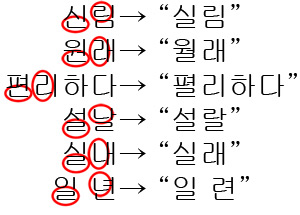Difference between revisions of "ㄴ + ㄹ"
From Korean Wiki Project
DigitalSoju (Talk | contribs) m (→Exceptions) |
DigitalSoju (Talk | contribs) m (→Other Examples) |
||
| Line 14: | Line 14: | ||
*신라 → "실라" | *신라 → "실라" | ||
*신랑 → "실랑" | *신랑 → "실랑" | ||
| + | *한라산 → "할라산" | ||
==Exceptions== | ==Exceptions== | ||
Revision as of 08:24, 10 February 2009
Pronunciation 'Rule:
If the 받침 is a ㄴ and it is followed byㄹ or if the 받침 is a ㄹ and followed by a ㄴ, the ㄴ sound becomes a ㄹ sound. This rule also applies even if ㄹ or ㄴ appear in another word, for example "일 년"(one year) gets pronounced as "일련."
Other Examples
- 곤란 → "골란"
- 연락 → "열락"
- 신랑 → "실랑"
- 문래 → "물래"
- 신라 → "실라"
- 신랑 → "실랑"
- 한라산 → "할라산"
Exceptions
The subway station "선릉역" frequently gets pronounced as "Seonleung," so the ㄴ gets pronounced as normal and the ㄹ pronounced as a /l/. Foreign names written in Hangeul also tend to ignore this rule, for example the name Henry would get transliterated as 헨리 and pronounced similarly to that of it's original English pronunciation rather than 헬리. Also Konglish words such as 원룸(one room) also get pronounced similarly to it's original pronunciation.
